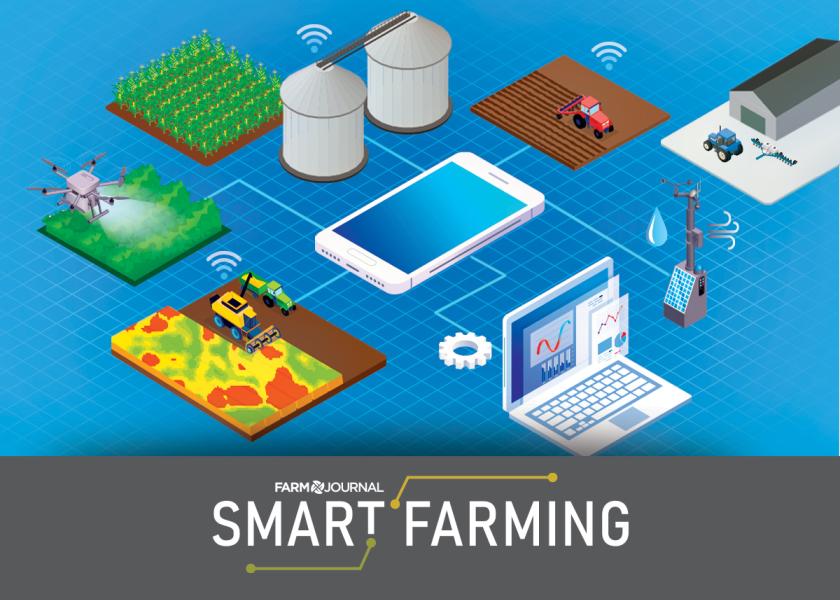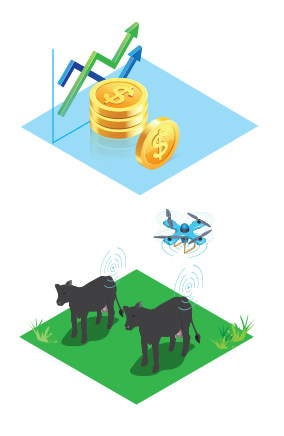Prioritize Technology That Works For You So You Can Farm Smarter

March 11-15 marks Farm Journal’s Smart Farming Week, an annual week-long emphasis on innovation in agriculture. Visit AgWeb often during the week, watch "AgDay" every day and "U.S. Farm Report" on the weekend, check out Farm Journal's YouTube channel and sign up for our newsletters, if you haven't already. The goal is to encourage you to explore and prioritize the technology, tools and practices that will help you farm smarter.
Sixth-generation farmer Lukas Fricke farms row crops and hogs with his brother, Brenden, near Ulysses, Neb. The partners adopted a data-first mindset upon taking over the 1,200-acre family farm during COVID-19.
Three years later, smart farming technology is abundant at Union Farms, including fully monitored grain storage, a connected equipment fleet and the latest in irrigation scheduling technology. The motivation is simple: farming smarter.
“Smart farming means making your life more efficient, so you don’t have to focus on the mundane but instead on making the best product possible,” Fricke says. “We only have so many hours in a day.”
The brothers have witnessed the potential of on-farm technology too many times to count: from a grain monitoring alert that kept stored grain from spoiling when Lukas was honeymooning in Belgium to no longer having to restart pivots in the middle of the night after rolling blackouts.
“With technology, we feel like we’ve got somewhat of a chance [at success],” he adds, noting how thinly spread the brothers’ time becomes.
Connectivity Is Crucial
Connected machines, implements and on-farm storage structures are a key component of a complete smart farming strategy. That includes the enabling software, usually mobile
apps on a smartphone, these tools require to work.
Than Hartsock, vice president of precision upgrades for John Deere, saw the power of connected machines firsthand on his family’s farm in south-central Ohio. This fall, Hartsock installed John Deere’s Precision Upgrades kit (satellite receiver plus in-cab display and guidance) on his father’s old green combine.
“My dad is an Operations Center user,” Hartsock explains. “He finally connected the combine, and the look on his face when he pulled out his phone and could see what the combine is doing and how it’s performing said it all. He doesn’t have to wait until he pulls out the USB stick, takes it back to the office and downloads the data into
a spreadsheet anymore.”
Trimble has been releasing connectivity, data telemetry and machine correction innovations for farmers for decades. The companies’ precision ag hardware solutions have a history of being white labeled and integrated into the back end of machines.
“[Smart farming] is using technology to digitally sense what’s going on in the field, or to digitally prescribe what you want to have happen in that field, and then applying that in a very precise way,” says Corey Buchs, senior product director, ag software, at Trimble.
“It’s about improving decision-making. We’re trying to enable data-based decision making. Instead of just doing what you’ve always done, look at the data,” he adds.
Tracey Wiedmeyer, co-founder of Gripp.ag, an AgLaunch class of 2024 startup, has a unique view of smart farming. He grew up on a farm and recently launched a mobile app to help farmers manage machinery performance and maintenance tracking across mixed fleets.
Wiedmeyer sees it as a strategy to leverage consumer tech approaches to the farm — and it’s working.
“Farming has leaned into the idea that technology needs to be complex – those days are coming to an end,” he says. “Enterprise software firms have been leveraging consumer technology approaches for a few years now. It puts farmers in the driver’s seat with technology that works for them instead of them having to work for the technology. That’s smart.”
Smart and Sustainable
Smart farming has always held vast potential, but today it’s heightened by the abundance of extreme, unpredictable weather patterns around the world. And then there are regions where the weather is consistent — consistently hot and dry, making water scarce. Crops still need to be produced in those areas.
Australia is one such place. A long history of drought has ushered in stringent regulations on how much water farmers can use for their crops.
John Gates, CropX chief revenue officer, says farmers there are enthusiastic to use technology to be more efficient and sustainable. CropX has a significant presence in Australia because the farmers there need irrigation and soil-sensing technology to get a crop out of the ground each year.
Many expect a similar near future. For growers in the U.S., smart farming technology is going to be critical to help farmers get every drop of water for their crops and livestock.
“You’re up against changes in weather, changes in seed genetics, changes in water resources; as a row crop grower you’ve got new and better genetics coming out every year, and you’re not going to know ahead of time that interaction with water necessity and demand,” Gates says. “You need tools, data and technology.”
Benefits of Using Smart Farming Technologies
- Reduced costs and increased farm profits.
- Improved workplace safety conditions and an enhanced quality of life.
- Reduced negative environmental impacts.
Watch this video to learn more about the smart farm of the future.
Want to read more about farming smarter?
Tall Order for Short Corn: The Latest On Short-Stature Hybrids
Spoiled Grain? There Are Apps for That
Damned By Data: State Destroys Farmer’s Yield, Pays $810,000 Damages







